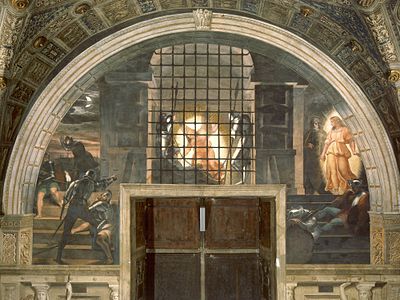| Revision as of 23:11, 16 January 2021 editMistico Dois (talk | contribs)Extended confirmed users52,423 editsNo edit summary← Previous edit | Revision as of 13:53, 15 August 2023 edit undoTartarTorte (talk | contribs)Extended confirmed users, New page reviewers, Pending changes reviewers, Rollbackers28,131 edits Change for to also include Liberation of St Peter from Prison (Jacopo di Cione) as it is also referred to by Deliverance of Saint PeterNext edit → | ||
| Line 1: | Line 1: | ||
| {{for|the biblical episode|Liberation of Saint Peter}} | {{for-text|the biblical episode|]|the work of art by Jacopo di Cione|]}} | ||
| {{Infobox Artwork | {{Infobox Artwork | ||
| | image_file=Raphael - Deliverance of Saint Peter.jpg | | image_file=Raphael - Deliverance of Saint Peter.jpg | ||
Revision as of 13:53, 15 August 2023
For the biblical episode, see Liberation of Saint Peter. For the work of art by Jacopo di Cione, see Liberation of St Peter from Prison (Jacopo di Cione).| Deliverance of Saint Peter | |
|---|---|
 | |
| Artist | Raphael |
| Year | 1514 |
| Type | Fresco |
| Dimensions | 560 cm (18 ft 4 in) wide |
| Location | Apostolic Palace, Vatican City |
The Liberation of Saint Peter is a fresco painting by the Italian High Renaissance artist Raphael. It was painted in 1514 as part of Raphael's commission to decorate with frescoes the rooms that are now known as the Stanze di Raffaello, in the Apostolic Palace in the Vatican. It is located in the Stanza di Eliodoro, which is named after The Expulsion of Heliodorus from the Temple. The painting shows how Saint Peter was liberated from Herod's prison by an angel, as described in Acts 12. It is technically an overdoor.
The fresco shows three scenes in symmetrical balance formed by the feigned architecture and stairs. In the centre the angel wakes Peter, and on the right guides him past the sleeping guards. On the left side one guard has apparently noticed the light generated by the angel and wakes a comrade, pointing up to the miraculously illumined cell. This adds drama to the serene exit of Peter at the right.
Gallery
References
- (Arnold NESSELRATH "RAPHAEL ET PINTURICCHIO" Louvre éditions page 177 "cette oeuvre peinte entièrement par l'artiste lui même")
External links
- The Vatican: spirit and art of Christian Rome, a book from The Metropolitan Museum of Art Libraries (fully available online as PDF), which contains material on this work
This article about a sixteenth-century painting is a stub. You can help Misplaced Pages by expanding it. |


